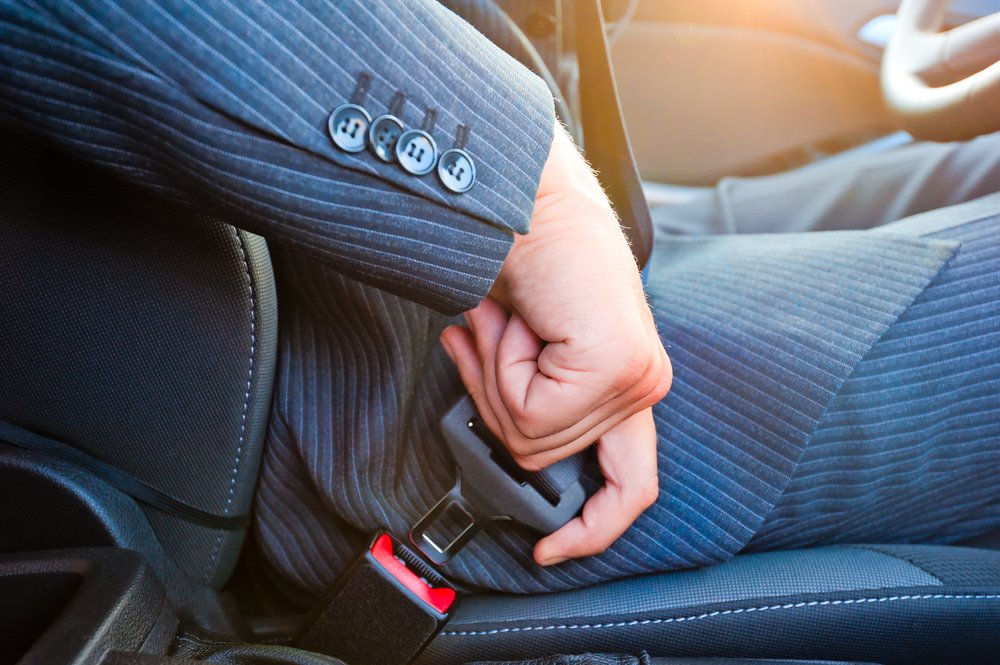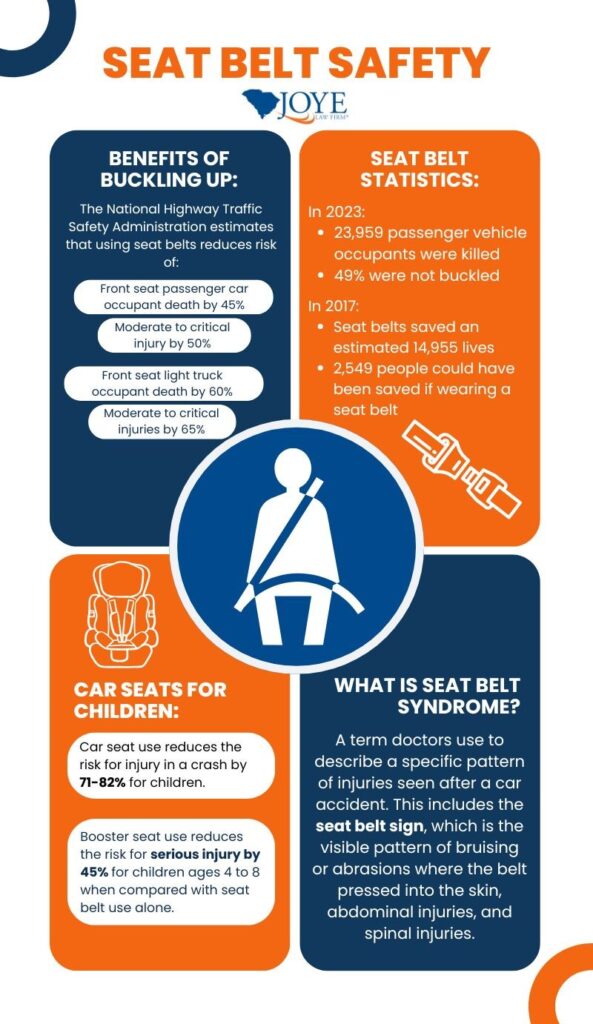
Seat belts have saved countless lives since becoming standard in most vehicles. According to the National Safety Council, proper seat belt use can cut the risk of deadly injuries by almost half for passenger vehicle occupants. While wearing seat belts is essential for safety, many don’t realize that seat belts themselves can sometimes cause certain injuries in a collision.
At Joye Law Firm Injury Lawyers, we have represented tens of thousands of car accident victims since 1968. Over the years, we’ve seen many clients who were wearing seat belts and still suffered serious harm in a crash. That’s because even when seat belts work exactly as designed, the seat belt force during a sudden impact can cause bruising, fractures, and damage to internal organs.
Understanding how these injuries happen, what symptoms to watch for, and your legal rights is an important part of protecting yourself after a crash. Our attorneys can explain what steps to take, help you pursue the compensation you deserve and guide you through the recovery process. At Joye Law Firm, your consultation is always free, and with our No Fee Guarantee, you won’t owe us anything unless we recover compensation for you.
Call us today at (888)-324-3100 to speak with a compassionate South Carolina car accident lawyer about your case.
How Seat Belt Injuries in South Carolina Auto Accidents Happen
Seat belts are designed to keep you from hitting hard surfaces inside the vehicle or being thrown from the car during a crash. In a motor vehicle accident, your body continues moving at the same speed as the car until the seat belt stops you. This sudden stop can generate significant force, especially in high-speed motor vehicle crashes. The lap belts hold your hips and pelvis in place, while the shoulder belt restrains your upper body. Although this action prevents fatal injuries, it can also cause damage.
The “seat belt sign”, a visible pattern of bruises or abrasions where the belt pressed into the skin, often signals deeper trauma. Internal injuries, such as abdominal injuries or damage to the rib cage, may not be immediately visible. In some collisions, defective seat belts or improperly worn restraints can worsen injuries.
For example, wearing a shoulder strap under the arm can put more pressure on the ribs, raising the chance of rib fractures. Even when worn correctly, vehicle restraints can create serious injuries if the crash forces are severe. Understanding these dynamics helps explain why prompt medical attention is critical after any car accident involving seat belts.
Common Seat Belt-Related Injuries
Seat belt injuries in auto accidents can range from mild bruising to severe trauma requiring surgery. The type and severity of injury depend on factors like the force of the crash, how the seat belt was worn, and the angle of impact. Below are the most frequently reported seat belt-related injuries, each with distinct symptoms and potential long-term effects.
- Soft Tissue Injuries: Damage to muscles, ligaments, and tendons in the chest, abdomen, or shoulders caused by the belt’s rapid tightening. These injuries often lead to pain, swelling, and reduced mobility.
- Abdominal Injuries: Compression from the lap belt can injure organs such as the liver, spleen, or intestines, sometimes requiring surgery.
- Chest Injuries: The shoulder strap and lap belt may cause rib fractures, lung injuries, or a fractured sternum, especially in frontal collisions.
- Spinal Injuries: Sudden forward motion of the head and neck can damage the cervical spine or lower back, occasionally resulting in spinal cord injury.
- Shoulder Injuries: Pressure from the shoulder belt may cause sprains, dislocations, or nerve damage in the shoulder area.
- Vascular Injuries: In rare but serious cases, compression from the belt can damage major blood vessels, creating a risk of internal bleeding and hematomas.
Understanding Seat Belt Syndrome
Seat belt syndrome is a term doctors use to describe a specific pattern of injuries seen after collisions. It includes the seat belt sign on the skin, abdominal injuries, and spinal injuries. This combination often points to serious underlying injuries that may not be obvious right away.
For example, someone might have only mild abdominal pain immediately after the crash, but further testing could reveal internal bleeding or damage to the intestines. Seat belt syndrome can also involve fractures to the pelvis and rib cage or injury to the thoracic spine. Because the force is transmitted through both lap belts and shoulder belts, the risk of multi-region injuries is high.
Medical professionals treat the seat belt sign as a warning to check for deeper trauma. Imaging studies like CT scans or MRIs are often used to detect internal organ damage and other injuries. Quick diagnosis and treatment are essential to avoid further complications.
For this reason, anyone showing the seat belt sign after a motor vehicle accident should seek immediate evaluation, even if they feel only minimal pain.
Special Considerations for Children and Booster Seats
Children are more vulnerable to seat belt injuries because their bodies are smaller and still developing. Adult seat belts may not fit them properly, which increases the risk of abdominal and spinal injuries. That’s why booster seats help by raising the child up so the lap belt and shoulder belt fit as intended.
Without a booster, the lap belt may press into the abdomen instead of the pelvis, leading to serious internal injuries in a crash. The National Safety Council reports that using booster seats correctly reduces the risk of serious injuries in children aged 4 to 8 by 45%. Vehicle restraints for children must also be installed and secured properly.
In motor vehicle crashes, improperly used booster seats can fail to prevent both ejection and seat belt-related injuries. Parents and caregivers should follow the vehicle manufacturer’s instructions for installing booster seats and ensure the belts are snug and in the correct position. This attention to detail can help prevent both fatal injuries and long-term harm from seat belt force.





